Discovering treasures in every port
Embarking in Portugal upon our first-ever cruise, my husband and I looked forward to the quality and service that have earned Viking River Cruises their outstanding reputation. There were many aspects of this river cruise that we loved, and having a wealth of compelling shore excursion opportunities was a big part of the experience for us.
Portugal is known for its famous explorers of centuries past who left the shores of the Iberian Peninsula searching for new lands and treasures. During our 8-day cruise of the Douro River, we discovered many treasures along the way in the beautiful vistas, cultural experiences, traditional food and wine, and interesting history.
We opted to take all of the included and optional excursions with guided tours and still had time to explore on our own. In many cases, we were able to interact with locals and get a glimpse of authentic ways of life in the Douro region of Portugal, too. We really enjoyed traveling in style for 8 days visiting fascinating places while always returning to the same location, our Viking Hemming stateroom. It offered the benefits of a road trip, which we really like, without having to change hotels each day.
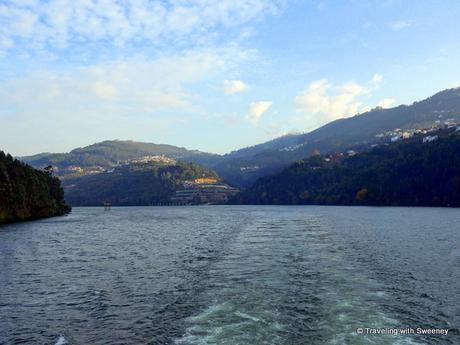
Sailing on the Douro River in northern Portugal on the Viking Hemming
Port of Call: Porto
Following a pre-cruise two-day stay in Lisbon (part of Viking’s “Portugal’s River of Gold” itinerary) and a stop for lunch and entertainment in the university town of Coimbra, we arrived in Porto to begin our journey on the Douro. But before setting sail, we enjoyed two wonderful shore excursions that I wouldn’t have wanted to miss.
Porto
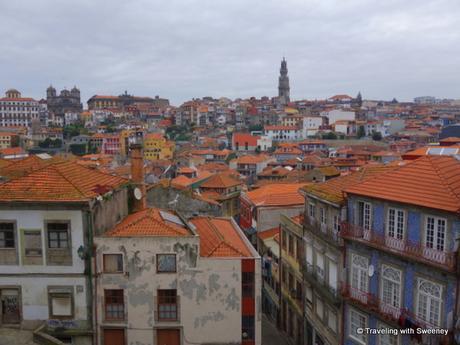
Over the rooftops of the colorful buildings of Porto, the tower of Clérigos Church is visible from many points in the city and surrounding area
Designated a European Capital of Culture in 2001, Porto is one of oldest cities in Europe and the second largest city in Portugal. With its striking six bridges over the Douro, Porto is often called the “City of Bridges”. Although there was some light rain when we visited, the city’s beauty and romantic ambiance were not diminished as we strolled the many steep, narrow streets past tiled buildings in Porto’s historic city center, a UNESCO World Heritage Site. Among the key places we stopped were Clérigos Church (its ornate altar shown below left) and São Bento railway station with its azulejos (blue and white painted and glazed ceramic tiles) depicting the history of Portugal.
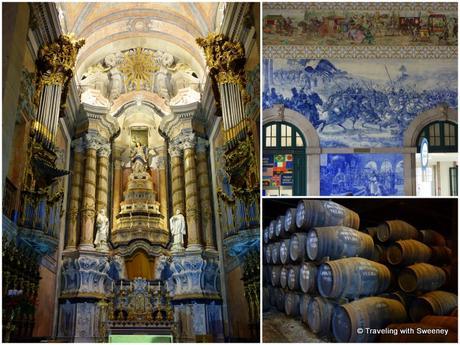
Clockwise from left: Ornate altar in Clérigos Church; azulejo murals in the São Bento railway station; oak casks with port wine at Real Companhia Velha cellars
As Porto is at the center of Portugal’s port trade, it was fitting that we had our first port wine tasting of the trip at Real Companhia Velha cellars (across the river from Porto in Gaia) where we sampled tawny and extra dry white varieties. There are many styles of port, several of which we sampled at wine estates throughout the Douro region and on board the Hemming.
Harry Potter fans would definitely want to visit the Livraria Lello (Lello Bookstore) where it’s said that J.K. Rowling spent time when she lived in Porto. They say the bookstore was part of her inspiration for the Harry Potter series. Although I’m not a fan, I’d love to visit the shop to see its beautiful decor and winding staircase. Unfortunately, there was a long line to get tickets and then another long line to enter the shop, and we didn’t have time to wait.
Guimarães
Settled in the 9th century, Guimarães is known as “the birthplace of the Portuguese nation” and was Portugal’s first capital in the 12th century. Its historical center is a UNESCO World Heritage Site, and it was also designated as a European Capital of Culture in 2012.

From top left: Guimarães medieval quarter, statue of Portugal’s first king, and Guimarães Castle
We had a lot of fun exploring on foot in Guimarães’ historic city center with its maze of narrow lanes and medieval plazas surrounded by shops, restaurants, and homes. Above the city center, Guimarães’ 10th-century castle dominates the hilltop.
Port of Call: Entre-os-Rios
Alpendurada Monastery
With old stone fireplaces blazing in this former monastery (now an inn) near Bitetos, we enjoyed the ambiance, traditional Portuguese food, and Alpendurada’s own vinho verde (which literally translates to “green wine”), young white wines. A high point of the night was a live performance of fado, Portugal’s deep folk music tradition characterized by soulful lyrics and melodies that evoke intense emotions such as longing, yearning, regret, and nostalgia.

Left: Fado singer and guitarist performing at the 11th-century Alpendurada Monastery; interior scenes of the monastery
Port of Call: Régua
In the heart of the port wine production region of the Douro, the town of Régua has a backdrop of hillside terraced vineyards. The sweet grapes used to make authentic port wine, Portugal’s most famous export, are only grown in the Douro Valley.
Vila Real – Casa de Mateus (Mateus Palace)
You may recognize the ornate baroque building from the labels of Mateus Rosé, the famous Portuguese wine export very popular in the 1960s and 1970s. The palace was built during the first half of the 18th century by Antonio Jose Botelho Mourao and is still used as a summer home by his descendants. We enjoyed a stroll through the palace’s extensive formal gardens, which were beautiful even on this early December day.
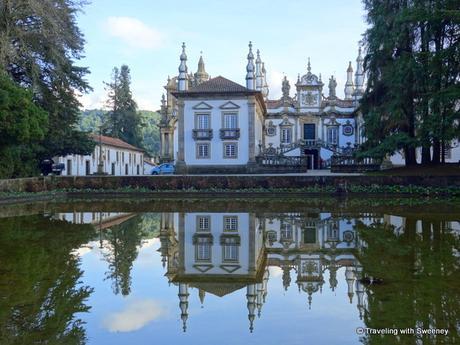
Reflections in the pond at Mateus Palace
Quinta do Seixo
Perched high on a hill overlooking the Douro Valley with vistas of mountains beyond is the wine estate of Quinta do Seixo. The road from the river to the top of the hill was especially narrow and winding offering edge-of-the-cliff thrills, but I had complete confidence in our highly-trained Viking coach driver who handled the switchbacks with ease.
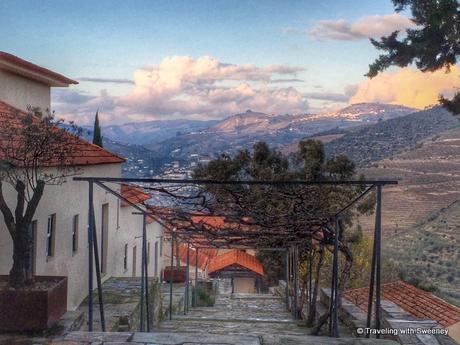
View of the Sandeman winery and Douro region countryside
The winery is home to the Sandeman brand of wines, whose logo of a Zorro-attired man holding a glass of wine may be familiar to you. We enjoyed the cellar tour and wine tasting, but the views were spectacular.
Lamego
On our return heading back to Porto, we docked once again in Régua affording us the opportunity to visit the bustling city of Lamego. Our time here was a highlight of our trip. We first visited the Santuario de Nossa Senhora dos Remedios (Shrine of Our Lady of Remedies) at the top of a baroque double staircase with nine terraces and 686 granite steps from the town center (although we didn’t actually count them). Devout pilgrims praying to be cured of their maladies climb these stairs, traditionally on their knees. The terraces are adorned with beautiful azulejo murals and statues. Although it was a foggy morning, we were taken with the beauty of the site and the view while descending the stairs.
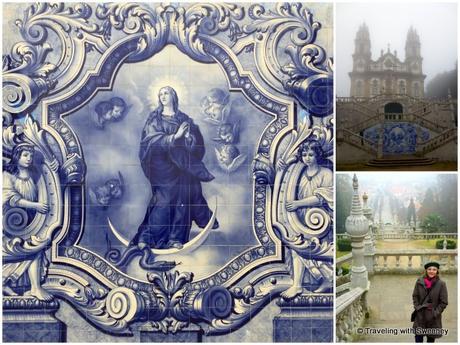
Gorgeous azulejo tiles adorn the terraced staircase from the city center to the Shrine of Our Lady of Remedies in Lamego
From there, we walked through the city center stopping to peruse local crafts at a small Christmas market that was just opening for the day and the season. At the local fresh market, our group met up with Viking Hemming Executive Chef Carlos Silva for a tour and insider’s look at the fish, meat, and produce of the market where he shops for the ship’s meals.
Port of Call: Barca d’Alva
Tucked in a hillside along the Douro, the village of Barca d’Alva with a beautifully lit bridge was our starting point for two wonderful excursions. When we arrived at the port, we got a glimpse of the quiet lifestyle of this small port village as we walked around in the early evening. Later, we returned to the town with a few of our fellow cruise guests for a nightcap of port wine in a café.
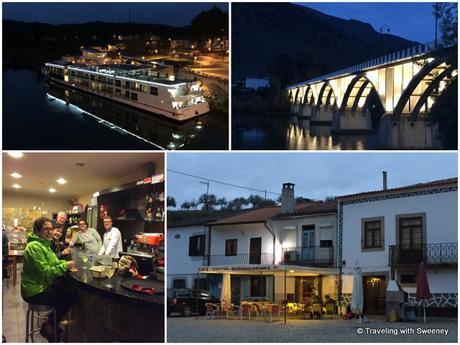
At port in Barca d’Alva, a view of the Viking Hemming from the bridge connecting Portugal to Spain; enjoying the company of fellow Viking guests in a village cafe.
Castelo Rodrigo
At Castelo Rodrigo, a small picturesque village where Jews, Arabs, and Christians lived peacefully together for centuries, we experienced a real step back in time. It is one of Portugal’s 12 historic parishes with a rich and diverse history that spans the arrival of its first inhabitants (about 500 B.C.), the Roman occupation, other invasions and conquests, the Spanish Inquisition in the 16th century (when it provided refuge for Jews fleeing the Inquisition), and its time as capital of Portugal. Today, in addition to being a national historic site, it is an agricultural area, largely due to the abundance of almond trees. The village has a small gift shop that sells a surprisingly large variety of flavored almonds — I bought some seasoned with lavender, but chocolate almonds seemed to be the most popular.
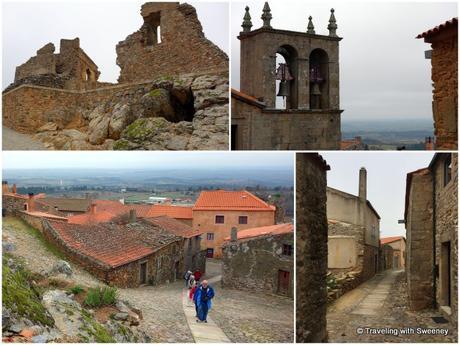
Walking along the steep lanes and paths of Castelo Rodrigo past ruins, modest homes, and the church
We climbed along its steep streets lined with modest homes and ancient fortress ruins, stopping to take in the views of the hills and Douro Valley. Castelo Rodrigo’s church (Our Lady of Rocamadour) with its rich interior of art, sculptures, and woodwork was founded in 1192 for religious pilgrims on their way to Santiago de Compostela, Spain on the Camino de Santiago (also known as the Way of St. James).
Beyond the Douro: Salamanca, Spain
The excursion to Salamanca was the farthest we traveled from a port and it was well worth the trip for the rural Spanish scenery we saw along the way (including a farm with a very large Iberian pig) and the vibrant university city of Salamanca, a UNESCO World Heritage Site.
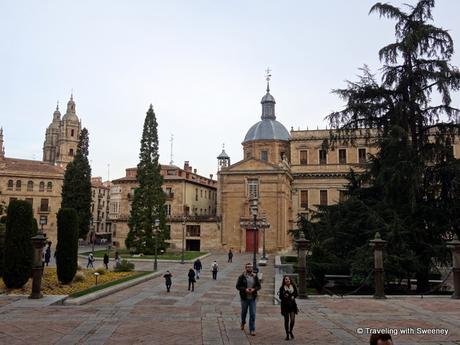
Salamanca, Spain
On our own and also during a guided tour we walked around the historic center admiring its many architectural attractions, including the 13-century university (which houses the oldest library in Europe); the stunning architecture and ornate interior of Salamanca Cathedral (both the new and old cathedrals); and the grand baroque Plaza Mayor, built between 1729 and 1755. Plaza Mayor is a busy square with shops and restaurants and is also a central gathering place for events and performances. On the day we visited, the stage was being set for the evening’s Nochevieja festivities, a huge event created for students to celebrate an early New Year’s Eve before going home to spend the holidays with their families. It draws about 40,000 people to the plaza and city center.
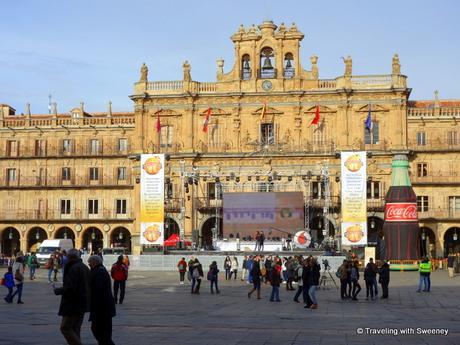
Preparations for Nochevieja festivities on Plaza Mayor
Port of Call: Pocinho
Favaios
This small village has a deep history producing bread and wine, especially moscatel, and has a nicely designed modern museum dedicated to the history and tradition of these two important products of Favaios.
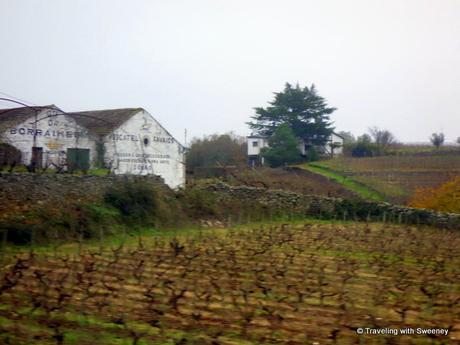
A moscatel wine estate in Favaios
On a foggy morning which added to the authentic and less-touristy ambiance of another of the Douro’s UNESCO World Heritage Sites, Favaios, we made our way up a steep cobblestone lane with not much more than our footsteps to be heard. Our destination was a modest bakery (one of 8 traditional bakeries in the town) where loaves of Favaios’ distinctive four-cornered bread were being formed and then baked in a wood-fired oven. We sampled some of the right-from-the-oven hot bread with jam and accompanied (as is the tradition) with a small glass of moscatel, totally disregarding the time of day. From the bakery, we moved on to a local moscatel wine cooperative for a tour and tasting, at least now a little closer to noon.
A very fun part of the visit to Favaios was a delicious dining experience at Quinta da Avessada, a lovely century-old winery with tasting room and small museum. Emphasizing Viking’s strong relationships with local businesses and communities, the winery had built a special large dining area for the enjoyment of Viking River Cruises’ passengers. We were greatly entertained by the local musicians and particularly the winery’s gracious owner, Luis.
Port of Call: Pinhão
The night before our last full day of exploring the Douro, we docked in the peaceful town of Pinhão, a UNESCO World Heritage Site in the center of the Douro wine region. Just a short walk from the ship was the village center where we strolled and did some window shopping. One of the attractions is Pinhão’s railway station with 24 azulejo murals depicting life in the Douro region. The village also has many shops including ones where you can find diverse items made of cork (including clothing and accessories).
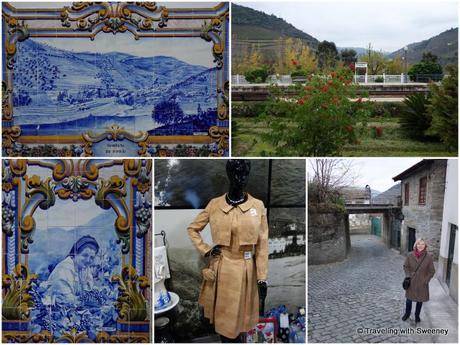
Murals of azulejo tiles at the railway station; strolling through the village, we found unique items made from cork, such as the dress (bottom center)
Return to Porto
Our exploration on the Douro River ended with a final night of fine dining, excellent service, and lively camaraderie among the guests as we docked again in Porto. The time had gone by much too quickly, but our treasure chest was loaded with great experiences and lasting memories.
Note about shore excursions: To reach our tour destinations, we were driven in new, immaculate, comfortable coaches with distances ranging from very short (across the bridge to Porto city center) to the longest, a little over an hour (to Salamanca, Spain). Most were about half an hour. Water was readily available on board and our friendly and knowledgeable Portuguese guides provided interesting commentary and history about the sights along the way and our destinations.

